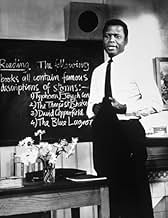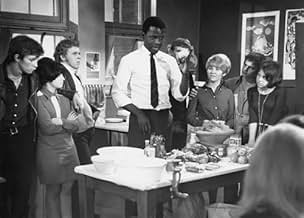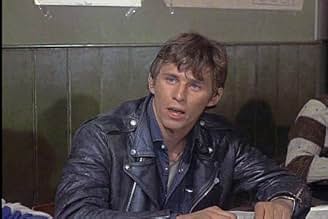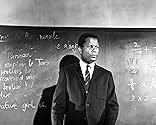Le esperienze di un ingegnere tirocinante idealista nell'insegnamento a un gruppo di turbolenti studenti bianchi delle scuole superiori dei bassifondi dell'East End di Londra.Le esperienze di un ingegnere tirocinante idealista nell'insegnamento a un gruppo di turbolenti studenti bianchi delle scuole superiori dei bassifondi dell'East End di Londra.Le esperienze di un ingegnere tirocinante idealista nell'insegnamento a un gruppo di turbolenti studenti bianchi delle scuole superiori dei bassifondi dell'East End di Londra.
- Regia
- Sceneggiatura
- Star
- Premi
- 1 vittoria e 3 candidature totali
Recensioni in evidenza
While not in the same league, the young cast of then-unknowns also perform quite well. Particularly effective of the young cast members is fresh-faced Judy Geeson, who brings unexpected depth to the stereotypical role of the young schoolgirl love-struck over Mr. Poitier (who could blame her). Director/writer/producer James Clavell avoids over-sentimentalization by inject his well-written script with a healthy dose of realism. The film may not be particularly striking, in the visual sense, but Clavell is a perfectly competent film maker, and his love of the material is evident throughout the entire picture.
Poitier noted in his autobiography the similarities in terms of racial issues between America and England. Filmed in London, the picture featured a number of minorities, many of whom, he observed, would be unable to find work outside of the confines of the movie. However, for his time spent with the cast, he was delighted with their company. Sidney played Mark Thackeray, one of his most famous characters, an engineer taking a teaching post as a stopgap between jobs. Eventually the relationship he develops with the students causes him to question his loyalty to the profession.
To Sir, With Love is often frowned upon nowadays due to its sentimentality. While not wholly condemned as a film, it is certainly regarded as the poor relation of Poitier's three 1967 works. This is an unfair assessment of a movie that commits the only crime of having its heart on its sleeve. And, though the late sixties would see an increase in the political situation, To Sir, With Love was the only one of the three Poitier vehicles that year that did not rely upon his colour for its subtext. Instead, a few bigoted remarks were inserted, largely from a fellow teacher (Geoffrey Bayldon as Mr. Weston) than the pupils. Compared to his other overshadowing works that year, direction paled, too, the camera-work at times almost static. However, the scope for Poitier as an actor was broader than in the other '67 roles, and certainly broader than in the 1996 TV sequel. Where there the plot would be propelled largely by one pupil, here multiple characters would be guided through numerous situations over an entire term period. Over the course of the lengthy film the viewer can feel as though they have experienced the timescale too. And who would argue that the sheer amount of silly moves Sidney and Judy Geeson perform in the final ball didn't directly influence Travolta and Uma Thurman in Pulp Fiction?
I first viewed this film when it was released in 1967, fifty long years ago and the year that I graduated from high school, an institution that was only a notch above the environment of North Quay. For me, this motion picture has actually improved in time, perhaps because I finally understand the words of the East Enders.
The use of the theme song "To Sir With Love" with all of its variations to match the mood of the moment was very successful. The montage sequence of still shots at the museum was also very effective, especially when one considers that the museum management refused to allow the crew from rolling their cameras inside. Talk about turning lemons into lemonade.
Two major instances of irony left a strong impact on me. The first was that of a highly educated black man teaching a predominantly white, underprivileged group of working class students in the inner city. The second was the sight of Sidney Poitier, who played one of those underprivileged students in a New York City high school twelve years earlier during "Blackboard Jungle", standing in front of a similar class as the teacher. In both movies, the teachers were faced with the same, difficult choice of leaving their troubled schools for careers elsewhere.
Although the subject of race arose with great restraint on several occasions during the movie, it did not bluntly expose itself until the moment when the mostly white students were asked to deliver flowers to the home of a bereaved non-white classmate. This was a moment of truth that was handled very well with a very moving and gratifying result.
Although several other reviewers don't agree with me, this is a film which has withstood the test of time. Thanks to the outstanding performance of "Sir" Sidney Poitier, an excellent script, a very capable, British supporting cast, and overall direction by James Clavell that kept me involved in the action from start to finish, this is a very appealing movie that must be seen.
Regrettably, there seems to be a shortage of this type of film, and I dare say that kids today are probably unfamiliar and unable to appreciate this type of product. Why do I think this? Maybe those kids are raised with the non-stop accompaniment of digital effects in every commercial and tv shows and would frankly not have the patience or introspection necessary to enjoy the film. Maybe they see it strictly as a 1967 period piece, which it isn't, because they lack a real understanding of how fine stories and emotions can be told in any time period. Anyhow, what a great movie.
Lo sapevi?
- QuizThe film did so unexpectedly well in the States that Columbia Pictures did market research to find out why so many people had gone to it. Their answer: Sidney Poitier.
- BlooperThe students in the class, most of the teachers at the school, and the vendors at the fruit and vegetable market wear the same clothes throughout the movie.
However, it is possible the students, are wearing the same clothes because their families cannot afford more than one set of clothing. During the funeral and museum outing scenes, some of the class are dressed differently, showing they have special clothes and school clothes. As for the vendors, it's possible they have specific clothes to wear to work in, whether or not for financial reasons.
- Citazioni
Mark Thackeray: [entering classroom and seeing smoke] All you boys, out. Girls stay where you are. Out.
[closes door]
Mark Thackeray: I am sick of your foul language, your crude behavior and your sluttish manner. There are certain things a decent woman keeps private, and only a filthy slut would have done this and those who stood by and encouraged her are just as bad. I don't care who's responsible - you're all to blame. Now, I am going to leave this room for five minutes by which time that disgusting object had better be removed and the windows opened to clear away the stench. If you must play these filthy games, do them in your homes, and not in my classroom!
- Curiosità sui creditiLulu received an "introducing" credit.
- Colonne sonoreTo Sir, With Love
Lyrics by Don Black
Music by Mark London (as Marc London)
Performed by Lulu (uncredited)
Arranged and Conducted by Mike Leander (uncredited)
I più visti
- How long is To Sir, with Love?Powered by Alexa
- What is 'To Sir, With Love' about?
- Is "To Sir, with Love" based on a book?
- What was burning in the classroom fireplace and why did the students burn it?
Dettagli
Botteghino
- Budget
- 640.000 USD (previsto)
- Lordo in tutto il mondo
- 2175 USD
- Tempo di esecuzione1 ora 45 minuti
- Mix di suoni
- Proporzioni
- 1.85 : 1
Contribuisci a questa pagina




































